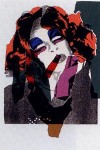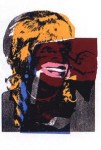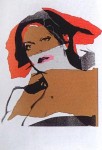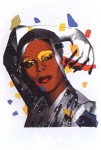- Ladies and Gentlemen | FS-II.128
- Ladies and Gentlemen | FS-II.129
- Ladies and Gentlemen | FS-II.130
- Ladies and Gentlemen | FS-II.131
- Ladies and Gentlemen | FS-II.132
- Ladies and Gentlemen | FS-II.133
- Ladies and Gentlemen | FS-II.134
- Ladies and Gentlemen | FS-II.135
- Ladies and Gentlemen | FS-II.136
- Ladies and Gentlemen | FS-II.137
Andy Warhol
Ladies and Gentlemen
Screenprint on Arches paper.
1975
43.5″ x 28.5″, image approx. 33.5″ x 26.5″
Edition of 125, 25 AP, 1 PP,signed, numbered and dated ’75 in pencil on verso.
Portfolio of ten screenprints.
Printer: Alexander Heinrici, New York
Publisher: Luciano Anselmino, Milan, Italy
Andy Warhol – Edition Prints – Ladies & Gentlemen
Sell/Buy Request Info
Andy Warhol Ladies & Gentlemen is a range of artworks created by artist Andy Warhol.
Ladies and Gentlemen: 1975 portfolio of ten screen-printed portraits of African American drag queens. The ladies and gentlemen pictured here have no proper names. Insofar as attaining fame and face necessarily involves getting, having, or making a name for oneself, these sitters will never be stars. Hence their anonymity is of an entirely different order than “the anonymous identity of all the stars.” These ladies and gentlemen Fail to become the anybodies who represent the abstract notion of celebrity. Instead, in the absence of specific names, they remain nobodies.
Beyond their lack of names, the most striking feature of the faces in these prints is their color. The fullness of nonwhite color in these prints alone offers a striking contrast to the celebrity portraits, a function that might initially be presumed to reflect the tonal difference of the sitters’ skin. However, at least in one case, the colors are used to reconstruct the sitter in blackface. While this may seem to make sense as a counterpart to the mask of whiteface, we should recall that the whiteness of the whiteface in the celebrity portraits does not call attention to itself Instead, it functions ideologically as unmarkedness. Given the historical precedent and political implication of blackface in U.S. popular culture, its reproduction in Ladies and Gentlemen is difficult to ignore, despite Warhol’s failure to comment upon or to call attention to it. Furthermore, unlike the celebrity portraits, the colors in this series function as interference, Where in most Warhol portraits colors are used to differen tiate the face from ground and to effectively pop the face into relief, in Ladies and Gentlemen the colors bleed across lines that distinguish face and ground, leaving the faces undifferentiated and, in some cases, nearly unidentifiable.
When Andy Warhol first burst onto the artistic stage in the 1960s’, he did so by incorporating images that were firmly embedded in the American psyche. His bright and colorful paintings and serigraphs presented images that were commonplace — a soup can or coke bottle — but were transformed by his technique into artistic icons of popular culture. Warhol was most interested in image and not reality, although one could say that by casting these mass produced commercial images in his own unique style, Warhol was making a comment on the reality of living in a world that was dominated by images from the advertising and entertainment industries. Warhol’s prints are in essence images of images. They are at least once removed, and often several times removed, from reality. His famous prints of Marilyn Monroe and Jackie Kennedy, not to mention countless other celebrities, are based on photographs. As in the case with Marilyn Monroe, many of those photographs are of his subjects posing as a character, not as themselves, a subtle reminder that once someone achieves a certain celebrity status, they become further and further removed from their real selves. How many layers must one remove to finally see the real person depicted in a Warhol print?











